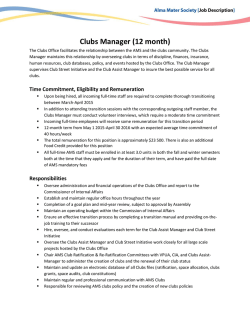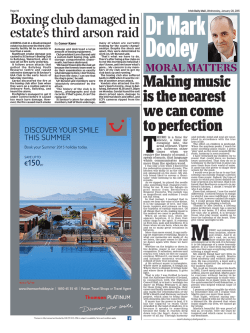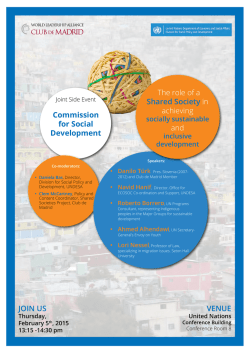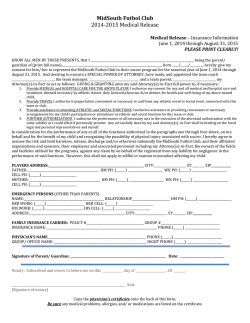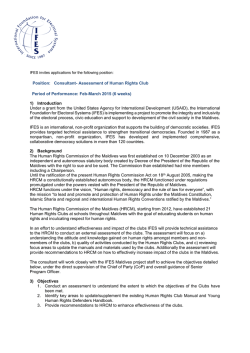
STRATEGIC PLAN
STRATEGIC PLAN 2015 – 2017 CONTENTS 1.Introduction 2. Overview of the Planning Process 2.1 Steering Group 2.2 Defining the criteria for a successful Strategic Plan 2.3 Identifying the priority action areas to be addressed by the plan 2.4 Designing a consultation process for the formulation of the plan 3. Headline Plan 3.1 Our Mission 3.2 Our Vision 3.3 Our Values and What They Mean 3.4 Statement of Goals 4. Goals, Implementation and Review 1. INTRODUCTION The GAA is the largest sporting organisation in Ireland with a network of over 2,000 clubs, including 392 affiliated international clubs. A total of 1,522,365 supporters attended intercounty football and hurling championship games in the 2014 season, while 89,022 children participated in Kellogg’s GAA Cúl Camps in summer 2014. The very significant level of interest in GAA sporting activity is reflected in the more than one million followers of GAA national, provincial and county Facebook and Twitter profiles. The National Strategic Vision and Action Plan 2009-2015 addressed areas of activity organised under eleven themes. It was developed following an extensive consultation process that included county and provincial officers and players, and it also drew upon a National Club Forum, where 300 representatives from clubs around the country discussed all aspects of GAA activity. Major progress has been made in the implementation of the plan in each of the eleven themes, duly reflected in the published mid-point review that was circulated to Congress 2012. Following this review, goals were set for the remaining years of the plan. The overall mission of the GAA has not changed since 2009. We continue to be a communitybased, volunteer organisation promoting Gaelic games and lifelong participation. Ireland, however, has changed significantly: the economic recession and the increase in youth emigration have had a major impact on clubs, creating challenges not envisaged when the 20092015 plan was formulated. It is time, therefore, to redefine our goals and actions for the coming three years to reflect both the progress achieved through the implementation of the National Strategic Vision and Action Plan 2009-2015 and the changed circumstances of Ireland today. This new plan covers the period 2015 to 2017, and has been developed following a more focused consultation process. It sets goals to guide our activities in six areas, identifies specific strategies to achieve each goal and defines measures of success. Unlike the previous plan, it sets goals for staff and national committees of volunteers at central level only. Provinces, counties and clubs will be encouraged to develop plans to realise their own goals within the framework of national policy. An Implementation Committee that will include an tUachtarán and Ard Stiúrthóir will take responsibility for overseeing the plan’s implementation. The first task of this committee will be to determine responsibilities and timelines for the implementation of the different elements of the plan. Coiste Bainistí will regularly review progress on the plan’s implementation and the Implementation Committee will provide a formal report on progress after 18 months. The objectives we are setting are ambitious but achievable, and they will assist both staff and national committees in supporting our units to reach their full potential. Liam Ó Néill Uachtarán Cumann Lúthchleas Gael Páraic Duffy Ard Stiúrthóir Cumann Lúthchleas Gael Aogán Ó Fearghail Uachtarán Tofa Cumann Lúthchleas Gael 2. OVERVIEW OF THE PLANNING PROCESS 2.1 STEERING GROUP In October 2013 the Association selected a representative group of volunteers and staff to participate in a steering group to develop the plan. The role of the steering group was to: • • • define the criteria for a successful Strategic Plan identify the priority action areas to be addressed by the plan design a consultation process for the formulation of the plan The steering group participants were: 1. Liam Ó Néill Uachtarán 2. Aogán Ó Fearghail Uachtarán-tofa (post Congress 2014) 3. Páraic Duffy Ard Stiúrthóir 4. Des Cullinane Corcaigh 5. John Horan Áth Cliath 6. Arlene McMahon Fear Manach 7. John Murphy Sligeach 8. Germaine Noonan Áth Cliath 9. Pat Teehan Uibh Fhailí 10. Michael McGuire Ros Comáin 11. Noel Quinn Dún na nGall 12. Colin Regan Liatroim We also wish to acknowledge the major contribution of Peter Hanan and Orla Cullen (Pinta) and Central Council staff members Lisa Clancy, Teresa Rehill and Ruairí Harvey. 2.2 DEFINING THE CRITERIA FOR A SUCCESSFUL STRATEGIC PLAN The steering committee identified the following criteria: 1. The plan should be ambitious, but also achievable. 2. The plan will not focus on all areas of the Association’s activities, but will limit itself to priority areas defined by the consultation process. 3. The action items undertaken in each priority area should be capable of clear measurement. 4. The priorities and projects should be distributed over the three years of the plan to reflect the capacity of the Association. 5. The plan should provide a framework for the work of staff and committees at national level. 6. The document should be clear and intelligible. 2.3 IDENTIFYING THE PRIORITY ACTION AREAS TO BE ADDRESSED BY THE PLAN The steering group identified six priority action areas: 1. Games 2. Clubs 3. Governance and Structures 4. Finance and Commercial 5. Communications 6. Cooperation within the Gaelic games family 2.4 DESIGNING A CONSULTATION PROCESS FOR THE FORMULATION OF THE PLAN A two-stage consultation process was organised by the steering committee. Stage one consisted of interviews, an online survey, and internal and external submissions; stage two consisted of the work of focus groups with volunteers and Croke Park staff. Stage-one consultations were carried out in December 2013 and in January, February and March 2014 with members of the following associations from the wider GAA family of games: • • • • Ladies Gaelic Football Camogie Handball Rounders Online Survey An online consultation process was completed in January 2014 and drew 13,901 responses. Respondents were asked to identify priority areas to be addressed by the Association over the next three years. Participants included: • • • • • • • • • Members Officers Players Spectators / supporters Coaches Overseas members Employees Parents Former players External submissions were received from: Internal submissions were received from: • • • • • • • Stage-two consultations were held following an analysis of the initial consultation findings. Focus groups, consisting of 40 nominated volunteers and staff at Croke Park, met on March 22 2014. Each group was assigned responsibility for one priority action area and was asked to refine the responses from the stage-one consultations. The feedback from each focus group was presented to the steering group in April for further refinement and approval. National committees Congress planning workshop Provinces Sponsors Steering group members consulted with their own respective clubs Irish Sports Council The Department of Transport, Tourism and Sport 3. HEADLINE PLAN 3.1 OUR MISSION The GAA is a community-based volunteer organisation promoting Gaelic games, Gaelic culture and lifelong participation. We are dedicated to ensuring that our games and values enrich the lives of our members, families and the communities we serve. We are committed to active lifelong participation for all and to providing the best facilities. We actively seek to engage with and include all members of our society. We promote individual development and well-being, and strive to enable our members to achieve their full potential in their chosen roles. 3.2 OUR VISION Our vision is that everyone be welcome to participate fully in our games and culture, that they thrive and develop their potential, and be inspired to keep a lifelong engagement with our Association. 3.3 OUR VALUES AND WHAT THEY MEAN Community Identity • • • • Amateur Status • • • Inclusiveness • • • • • Player Welfare • • Teamwork • • Community is at the heart of our Association Everything we do helps to enrich the communities we serve We foster a clear sense of identity and place We support our members in contributing to the well-being of their respective communities We are a volunteer-led organisation All our players and members participate in our games as amateurs We provide a games programme at all levels to meet the needs of all of our players We welcome everyone to be part of our Association We support the needs of all of our members Respect We respect each other both on and off the playing fields We operate with integrity at all levels We listen and respect the views of all We provide the best playing experience for all of our players We structure our games to allow players of all abilities to reach their potential The cornerstone of our Association is effective teamwork on and off the field Ní neart go cur le chéile (There is no strength without working together) 3.4 STATEMENT OF GOALS The strategic goals from 2015 to 2017 are: 1. to increase player and member participation and to support the continued growth of the Association 2. to improve support for county and club volunteers 3. to implement a governance code that will strengthen all units within the Association 4. to improve the financial, commercial and fundraising framework for our units 5. to utilise all communication platforms to engage effectively with players, coaches, administrators, members, supporters and the wider public 6. to develop our partnership with an Cumann Camógaíochta and Cumann Peile Gael na mBan 4. GOALS, IMPLEMENTATION AND REVIEW In the section to follow, each of the six strategic goals are addressed as follows: • • • 20 the specific strategies to be employed to achieve each goal are identified; the specific steps to be undertaken under each individual strategy are identified; the measurement of the success of each individual strategy is identified. 21 GOAL 1: TO INCREASE PLAYER AND MEMBER PARTICIPATION AND TO SUPPORT THE CONTINUED GROWTH OF THE ASSOCIATION STRATEGIES 1.1 1.3 Develop a recruitment programme to attract and retain players and members. To achieve this we will: • Ascertain exactly the number of players and members in each club • Conduct baseline research to identify those factors that at present act as either barriers to or facilitators of membership • Develop and implement a recruitment campaign • Develop an online member-induction programme for new members • Review success of recruitment campaign in attracting new players and members to clubs • Explore the establishment of a membership benefits programme Measure of success: • Implementation of recruitment programme • An increase in the number of registered full, youth and social members in each club 1.2 Implement new models of participation in both urban and rural areas to deal with the increase/decrease in playing numbers. To achieve this we will: • Review and revise rules on playing eligibility, as necessary, to encourage additional participation • Develop participation centres (Youth Centres) in each county Measures of success: • Number of county engagements with new models • An increase in playing numbers • Well-utilised and vibrant Youth Centres Increase participation in recreational games across the Association. To achieve this we will: • Develop and launch GAA National Recreational Games (NRG) including hurling, Gaelic football, handball and rounders • Identify specific target groups • Develop tailored communication campaigns for specific groups Measure of success: • The implementation of nationally co-ordinated GAA NRG leagues in the four provinces 1.4 Develop a programme to retain players in the 12-20 years age-group. To achieve this we will: • Examine successful programmes that have resulted in maintaining the involvement of players at this level • Devise proposals to keep players in this age-group playing Gaelic games • Pilot a programme in four counties Measure of success: • A documented set of proposals • A successful pilot in four counties • A reduction in the level of player drop-out in this age-group 1.5 Re-examine fixture planning/scheduling to identify issues and solutions and to deliver a co-ordinated fixture plan for all levels. To achieve this we will: • Review the calendar of inter-county fixtures with a view to facilitating a regular programme of games for club players • Identify current examples of excellence within fixture-planning and define best practice • Develop a co-ordinated fixture-plan template, while implementing decisions agreed in the reports of the Football Review Committee and the Hurling Review Committee Measures of success: • The implementation of co-ordinated fixture planning/scheduling • The provision of a meaningful calendar of match activity and a defined closed season for all players 1.6 Develop a strategy to raise awareness of Association policy concerning the welfare of our club members and players, coaches and administrators. To achieve this we will: • Review existing policies • Develop and conduct an educational campaign to inform club members and players, coaches and administrators of GAA policy and focus our efforts on the areas of player welfare, health and wellbeing, and personal development • Devise and implement a communications plan for the campaign Measures of success: • Greater opportunities for personal development for our volunteers • An increased awareness of player-welfare issues throughout the Association • An improvement in player-welfare practice at club level 1.7 Review and renew the coach-accreditation programme at all levels within the Association. To achieve this we will: • Complete an evaluation of the current coach-accreditation programme • Renew and re-launch the programme • Develop and maintain a database of accredited coaches Measure of success: • Enhancement of coach-accreditation programme and database 1.8 Improve the current process for recruiting, training and mentoring referees. To achieve this we will: • Complete an evaluation of the current recruitment, training and mentoring programmes for referees • Develop and launch a model of excellence for refereeing within each county Measures of success: • The implementation of a programme of recruitment, training and mentoring of referees in all counties • An increase in the number of retired players continuing their involvement with the Association as referees GOAL 2: TO IMPROVE SUPPORT FOR COUNTY AND CLUB VOLUNTEERS STRATEGIES 1.9 Establish the Respect Programme as a core element of playing our games. To achieve this we will: • Complete a review of the Respect Programme to date • Pilot an integrated initiative with Camogie clubs and Ladies Gaelic Football clubs in each province • Develop greater awareness of the programme through: (i) use of the Respect logo on club and county jerseys; (ii) recruitment of programme ambassadors on all county teams; (iii) creation of affordable signage for clubs; (iv) adoption of the programme as part of coach- education delivery and child-welfare awareness training • Recognise successful implementation of the Respect Programme by our units through a Provincial award scheme Measures of success: • Greater awareness of the Respect Programme among players of all age-groups, parents, supporters and the general public • Greater visible impact of the Respect Programme message in our games 1.10 2.1 Develop and implement online and trainer-based education and development programmes for volunteers to enable them to assume leadership roles within counties and clubs. To achieve this we will: • Pilot three volunteer-education modules through online platforms and through a trainer-based programme to assess the effectiveness of both forms of delivery • Review this pilot and consider implementing programmes for all county and club- officer roles Measure of success: • Implementation of pilot programme • The provision of an accredited education and development programme for county and club volunteers within each county • Number of volunteer engagements within counties 2.2 Develop and implement a club support programme that includes a recognition component to facilitate continuous improvement at club level. Develop a strategy to increase participation of international units. To achieve this we will: • Complete a review, in consultation with units abroad, of international structures • Identify programmes to assist international units in promoting Gaelic games • Develop a plan, in consultation with international units, that outlines actions for the GAA worldwide Measure of success: • An increase in numbers participating in Gaelic games and in the number of games played by international units To achieve this we will: • Obtain feedback from clubs and identify gaps in current provision • Devise a club support programme that will include modules on club development and club planning • Implement the programme across all clubs through a team of trained facilitators at county level Measures of success: • The provision of the club support programme to clubs • The existence of vibrant, well-resourced and well-supported clubs 2.3 Promote best practice for access and facilities. To achieve this we will: • Assess the current level of accessibility in club premises for people with disabilities • Devise a guide for clubs on appropriate facilities for children and adults with disabilities • Publish a facilities-provision policy outlining minimum standards, best practice and funding opportunities • Enhance current health and safety guidelines for all clubs relating to their facilities • Communicate availability of best practice guidelines Measures of success: • A baseline report on the accessibility of club premises • An improvement in standards at all our facilities in line with published facilities- provision policy • An awareness of health and safety requirements in all clubs • Improved accessibility in club premises for people with disabilities 2.4 Increase awareness at club level of the tools and resources available to support members. To achieve this we will: • Communicate availability of and highlight online resources and assistance available to clubs • Measure the take-up of the various online resources available to clubs Measures of success: • The completion of promotional activities relating to utilising online club tools and resources • Greater utilisation of the Association’s online resources, tools and communications systems. GOAL 3: TO IMPLEMENT A GOVERNANCE CODE THAT WILL STRENGTHEN ALL UNITS WITHIN THE ASSOCIATION GOAL 4: TO IMPROVE THE FINANCIAL, COMMERCIAL AND FUNDRAISING FRAMEWORK FOR OUR UNITS STRATEGIES STRATEGIES 3.1 To achieve this we will: • Consult with members and review current governance structure/practices • Research best practice and ensure that any new structure of governance can be implemented • Develop and implement a governance code for each level of the Association • Continually review the effectiveness of the code and amend as required Measure of success: • Full compliance with the governance code 3.2 3.3 Establish principles of good governance that will enhance the reputation of the Association. Provide mentoring and training to administrators for effective implementation of governance model. To achieve this we will: • Engage with training experts to develop a training plan • Develop an online tool to assist clubs in the implementation of the code • Use expertise within the Association in mentoring administrators Measures of success: • Administrators having sufficient training to implement the new governance model throughout the Association • Operation of a governance code within the Association Promote the up-skilling of members who aspire to be nominated for officerships within County Committees/Provincial Councils To achieve this we will: • Update roles and responsibilities of officerships • Inform the relevant committees of the desirable requisites for the various roles • Develop accredited GAA-specific courses for potential officers Measures of success: • Clearly defined roles and responsibilities for each officer • Awareness from committee members of the requisites for successful fulfilment of each role • Election of people with requisite skills to officerships within County Committees / Provincial Councils 4.1 Establish alternative means of funding the long-term development plans of the Association. To achieve this we will: • Evaluate alternative models of debt and equity financing • Present the outcome of the evaluation and make recommendations to the National Finance Committee and Coiste Bainistí Measure of success: • The availability of alternative funding sources 4.2 Develop the potential of the National Club Draw. To achieve this we will: • Create a group within Croke Park comprised of volunteer and full-time staff with responsibility for the development of the National Club Draw • Increase the revenue to clubs from €2million per annum to €5 million per annum over three years Measure of success • Clubs benefitting by €5 million annually by 2017 from the National Club Draw 4.3 Determine the potential for collaborative sponsorship opportunities for club and county units. To achieve this we will: • Work with a number of counties to explore the merits of offering a shared sponsorship opportunity to potential partners • Pilot a collaborative concept so that counties will benefit from a collective arrangement with other counties and a commercial partner • Subject to result of pilot, potentially develop a suite of potential collaborative opportunities for prospective partners Measure of success: • Cooperation from counties to assess merits of the concept • Production of a report assessing the viability of opportunities • Availability of collaborative opportunities model for clubs and counties • The pilot of collaborative sponsorship agreements in a sample of clubs and counties 4.4 Develop a national procurement programme that will benefit all units. To achieve this we will: • Examine opportunities to identify savings for all units resulting from group purchasing initiatives Measure of success: • The implementation of a national procurement programme 4.5 Create a new licensing process for playing gear and merchandise that includes both clubs and counties. To achieve this we will: • Develop a national agreement with associated pricing for club and county units • Pilot a centralised licensing framework in three counties • Review the pilot scheme and implement a new licensing model across the Association Measure of success: • The achievement of savings for clubs and county units in relation to playing gear and merchandise 4.6 4.7 Continue our drive towards Financial Excellence as espoused in the GAA Strategic Vision and Action Plan 2009-2015 To achieve this we will: • Maintain momentum on the individual work-streams identified in the 2009-2015 plan • Review and reset goals in the above areas so as to facilitate clear measurement of progress • Re-double efforts to provide the best possible tools, training and support to our volunteers and units in the pursuit of our common financial goals Measure of success: • The publication of, and means of measuring achievement against, financial goals for 2015-2017 Provide a more equitable distribution of funding to counties, taking account of population, participation, resources and commercial potential. To achieve this we will: • Articulate a vision for more equitable funding of counties • Develop and implement a new framework to support a fairer funding structure • Implement and review the operation of the revised funding model Measure of success: • The implementation by, and acceptance within, the Association of a more equitable funding distribution programme 4.8 Work with the GPA to review it’s financial model and ensure that the model continues to meet the agreed objectives of our shared approach. To achieve this we will: • Review the current funding model during 2015 as required by the Recognition Protocol between the GAA and GPA • Support the GPA in its delivery of the Player Development Programme and other services Measure of success: • Agreement on a long term funding framework for the GPA GOAL 5: TO UTILISE ALL COMMUNICATION PLATFORMS TO ENGAGE EFFECTIVELY WITH PLAYERS, COACHES, ADMINISTRATORS, MEMBERS, SUPPORTERS AND THE WIDER PUBLIC STRATEGIES 5.1 Provide a comprehensive communication and engagement framework for club members. To achieve this we will: • Evaluate current engagement methods and research best practice • Research and plan the use of emerging technology platforms on a continuing basis to ensure that the GAA embraces the best new technologies • Create, through the use of digital platforms, online communication and feedback forums with members to allow them to engage effectively with the Association Measures of success: • Improved communication and engagement with members • Better public awareness of the GAA and the social dividend it provides • Increased awareness of the level of investment made by the GAA in development of facilities throughout the country 5.2 Create a communication-skills training and support programme for players, coaches and administrators. To achieve this we will: • Launch a communication-skills programme for each of the above groups Measure of success: • The organisation of annual training and support programmes in communications in all counties 5.3 Devise a new IT strategy to better utilise current and future technologies to further the core aims of the Association To achieve this we will identify: • The core aims where technological innovation will contribute to achievement of these aims • The technological means to make this correction • The human, financial and technical resources necessary to so apply these technologies Measure of success: • The publication and implementation of a new strategy 5.4 Continue to explore and develop new ticketing products, processes and technologies to help increase attendances at all levels To achieve this we will: • On an ongoing basis; identify, monitor and evaluate the constantly evolving ticket-related technology that may improve ticketing • Benchmark ticketing operations against other leading national and international organisations • Work with all units and partners in the development and deployment of any new ideas Measure of success: • Greater engagement with ticketing initiatives 5.5 Devise a strategy to support volunteers in the promotion and use of the Irish language. To achieve this we will: • Formulate a plan for the Irish language in line with government strategies • Identify priorities areas, goals, strategies, actions and KPI’s Measure of success: • Greater use and visibility of Irish language within the Association • Achievement of KPI’s GOAL 6: TO DEVELOP OUR PARTNERSHIP WITH AN CUMANN CAMÓGAÍOCHTA AND CUMANN PEILE GAEL NA mBAN STRATEGIES 6.1 Establish a working group to improve co-operation across the three Gaelic games’ organisations. To achieve this we will: • Work with the Ladies Gaelic Football Association and the Camogie Association to develop an umbrella working group that will facilitate closer links between the three Associations • Present a detailed proposal for approval by the GAA and by the respective organisations • Decide on the establishment of a new body Measure of success: • The participation of all three organisations in an effective national partnership group • More effective utilisation of resources, knowledge and expertise • Success of projects coordinated by the integrated working group 6.2 Promotion of the ‘One Club’ model. To achieve this we will: • Encourage and support more clubs to adopt the ‘One Club’ model • Provide appropriate support and advice, as necessary, for integration • Establish an awards/recognition programme for best ‘One Clubs’ Measure of success: • Having the ‘One Club’ model in place in all clubs where the opportunity for integration exists • Number of clubs integrated under the ‘One Club’ model 33 STRATEGIC PLAN 2015 – 2017
© Copyright 2025
